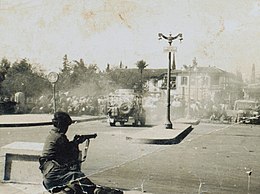
Back حالة الطوارئ القبرصية Arabic সাইপ্রাসের জরুরি অবস্থা Bengali/Bangla Zypriotischer Unabhängigkeitskrieg German Απελευθερωτικός Αγώνας της Κύπρου 1955-59 Greek Emergencia de Chipre Spanish Insurrection de Chypre French מצב החירום בקפריסין HE Kedaruratan Siprus ID Emergenza cipriota Italian Emergência de Chipre Portuguese
| Cyprus Emergency | |||||||
|---|---|---|---|---|---|---|---|
| Part of the Cyprus problem and Decolonisation | |||||||
 A street riot in Nicosia during the Battle at Nicosia Hospital in 1956 | |||||||
| |||||||
| Belligerents | |||||||
|
|
| ||||||
| Commanders and leaders | |||||||
|
|
| ||||||
| Strength | |||||||
|
|
300 fighters[4] 1,000 active underground[5] | ||||||
| Casualties and losses | |||||||
|
371 dead (according to Roll of Honour's database) and 21 British Policemen 601 injured[6] |
102–112 killed (including 9 executed) Unknown injured[7] | ||||||
The Cyprus Emergency[note 1] was a conflict fought in British Cyprus between April 1955 and March 1959.[8]
The National Organisation of Cypriot Fighters (EOKA), a Greek Cypriot right-wing nationalist guerrilla organisation, began an armed campaign in support of the end of British colonial rule and the unification of Cyprus and Greece (Enosis) in 1955. Opposition to Enosis from Turkish Cypriots led to the formation of the Turkish Resistance Organisation (TMT) in support of the partition of Cyprus. The Cyprus Emergency ended in 1959 with the signature of the London-Zürich Agreements, establishing the Republic of Cyprus as an independent state.[9]
- ^ French 2015, p. 302.
- ^ Schofield, Clive H. (2002). Global Boundaries: World Boundaries Volume 1. Routledge. ISBN 9781134880355.
- ^ "Cyprus Emergency Deaths 1955–1960". findmypast.co.uk.
- ^ a b Fall, Bernard B. (1998) [1965]. "The Theory and Practice of Insurgency and Counterinsurgency". Naval War College Review. 51 (1): 55–56. ISSN 0028-1484. JSTOR 44638001.
Remember that the British fought in Cyprus, and seemingly had everything in their favor. It is an island half the size of New Jersey. The Royal Navy, which can be trusted to do its job, sealed off the island from the outside. There were 40,000 British troops on Cyprus under Field Marshal Sir John Harding, and his opponent, Colonel [George] Grivas, had 300 Greeks in the EOKA [National Organization of Cypriot Struggle]. The ratio between regular troops and guerrillas was 110-to-1 in favor of the British! After five years the British preferred to come to terms with the rebels.
- ^ Kraemer 1971, p. 146.
- ^ French 2015, p. 307.
- ^ French 2015, pp. 66, 307.
- ^ Lim, Preston Jordan (2018). The Evolution of British Counter-Insurgency during the Cyprus Revolt, 1955–1959. Springer. p. 12. ISBN 978-3-319-91620-0.
The term "Cyprus Emergency" more precisely refers to events occurring between 26 November 1955, when Governor John Harding declared an official state of emergency, and Grivas' departure in March 1959.
- ^ "Historical development". eurydice.eacea.ec.europa.eu. Retrieved 21 January 2024.
Cite error: There are <ref group=note> tags on this page, but the references will not show without a {{reflist|group=note}} template (see the help page).